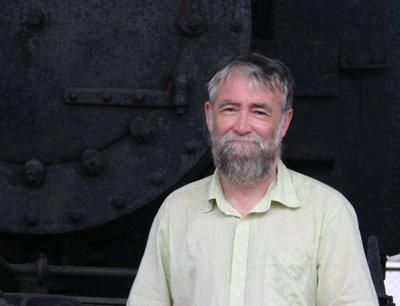Railway Roundabout
A look at railways both in Japan and around the world
Thursday, August 31, 2006
Kominato Railway

We had to pick up someone from JR Goi station station just south of Chiba yesterday. It's the junction too for the Kominato Railway, an almost ridiculously pittoresque private line that heads west into rural Kazusa and links up with another private line that will take you down in a bumpy railcar to Ohara on the Pacific Coast.
The Kominato workshops are at Goi - untidy old timber buildings full of lathes and the like out of the ark and dedicated to keeping their vintage railcars moving. It all dates back to the 1920's when the line was built - or at least looks like it. An absolute gem, worth a trip to Japan just to ride this one I would say.
And next to the workshop is this wonderful tin shed sheltering three veterans from the rain. I wonder if any of them could be restored to working order now, I'm sure that in the UK someone would leap at the chance. There are two Baldwin 2-6-2T's (Nos. 1 and 2) built in the USA in May 1924 (Works nos. 57776 and 57777)And next to them is a Japanese Imperial Railways B10 4-4-2T (yes - an 'Atlantic' tank!) No. B104.
Does anyone know if the Baldwin drawings from that era are in an archive somewhere? I'd love to build a 7mm model of one of these.
Tuesday, August 29, 2006
Mytsery Grice

A mystery grice today. I was in Tsudanuma and walked down the stairs to the platforms and there was this train waiting 'in the hole' in Platform 2 hauled by a Bo-Bo diesel switcher. Unfortunately and as these things always turn out it got a clear road about 15 seconds after I got there so it was off before I could get some good photos.
What is it I wonder? There were three coaches in the set and 0ne was numbered 'ki-ya 192-1' and had a logo that read 'East-i D'.
My guess is that it is a new test train for checking the permanent way quality and the alignment of the catenary. It was absolutely packed out with high-tech electronic gear. A while back there was an article in 'Tetsudo-fan' about the latest shinkansen unit for testing the track - yes, they have a dedicated five car train. It was a similar livery and I think called 'East-i'. So I guess this is the 1070mm gauge counterpart.
Monday, August 28, 2006
Super Azusa
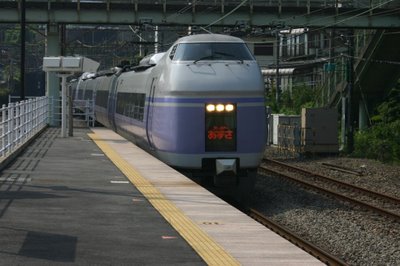
There are scores of 'named trains' running on Japanese Railways and here's one that I always think is pleasingly 'exotic' because of the 'bubble car' design of the front end of the EMU units. This is the 'Super Azusa'
The 'Azusa' was a train in steam days on this line and I think the name comes from a mythical bow used by Shinto deities. It runs from Tokyo(Shinjuku) to Matsumoto in the central ountains of Honshu, a run of about 150 miles, calling at Chino, Kofu, O-tsuki and Hachioji. The 'Super' version runs I think four times a day and only calls at Kofu.
Nice looking train. This picture was taken at a wayside station on my way back from O-tsuki last week when our local train was waiting 'in the hole' on the platform to the left for the 'pass'. I'd guess there was less than two minutes between us pulling up and the express rolling by, typical of JR's passion for split second timing.
Sunday, August 27, 2006
Fuji Railway

On my trip to the MAGLEV line last week I had to catch a train on the Fuji Railway, one of hundreds of private railways in Japan. I don't have the statistics to hand but I seem to remember that the combined length of private lines is almost as much as the national JR system
If I could find the same book I'm looking for I could also tell you when the line was opened. But it's around 20 miles long and runs from O-tsuki up to the northern slopes of Mount Fuji. If you want to climb the mountain this is the easiest way to reach it. Maybe next year!
Many of the smaller private railways are 3'6" gauge and in fact the Fuji Railway has a junction with JR although I don't think there is any regular through running. Most trains are as you see here - two or four car EMU's.
It all reminds me of Switzerland or Austria a bit. Better service though - about three trains each way an hour.
Friday, August 25, 2006
A few more MAGLEV photos
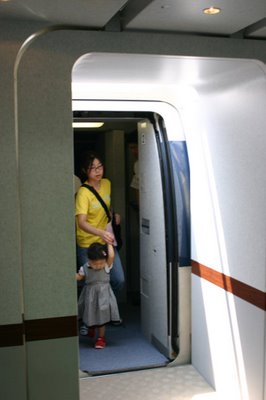
I'm feeling lazy today so I thought I'd post three more of my photographs from my trip to Yamanashi yesterday. This first one is of the 'airport-like' access to MAGLEV trains. I can't see this ever catching on with gricers eh? No draughty acres of concrete platform to sit and eat your cheese and onion sandwiches on here ...

And here's the back 'slow end' of the test train - the end first designed for 350 km/h running. So when the train is running west to east that is still the maximum test speed. Just heading out over the points onto the main line ...

And finally here's another shot of an east to west 500 km/h run. It's across this valley in about five seconds, so you can see why I say it's like trying to photograph fighter aircraft. This has to be one of the worlds great train photographing vantage points though.
Back to normal speed tomorrow - on the Fuji line ...
Thursday, August 24, 2006
Ultra-speed gricing
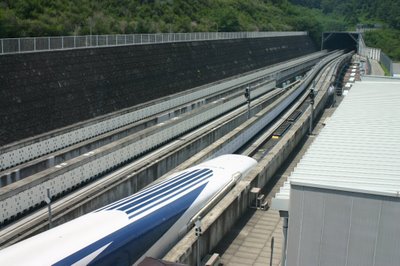
Some ultra-speed gricing to report on today. I’m just back, very hot and tired, after making the trip over to Yamanashi Prefecture for my ride on the ‘Linear Express’ MAGLEV train. The line runs under the mountains a few miles south of JR’s Chuo Line so to get there you take the Tokyo – Kofu train and get off at O-tsuki to catch the small private Fuji line for three stops. Then you walk over the hill to the test centre.
Wow! Was I impressed! It’s much more like a plane than a train I guess, a ‘plane’ of coaches that flies a few inches above the ground. The levitation cuts in and out at about 70 mph.

There are two parallel test tracks, the north and south, but only the north was running today – the other is used to trial ‘passing tests’ with a second unit. Out trip comprised four movements, firstly out onto the main line about for 10 km west, then reverse for a run east for about 25 kilometres at around 200 mph. And then the FAST one – back west again accelerating quickly to 500 kph (312 mph). Finally back to the station.
Lovely ride. The acceleration was just amazing and so smooth, but you could really feel the power there.
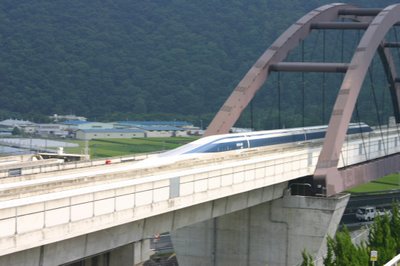
After my trip I hung around to watch the next one and caught the train at 300 mph on the next run. There’s a great gricer’s vantage point on the adjacent hill and they even helpfully warn you when it’s going to come out of the tunnel in the opposite hillside but it’s a bit like trying to photograph low-flying fighter aircraft. I don’t suppose I’ll ever grice anything faster than that.
Tuesday, August 22, 2006
Gricing at Stenkrith

Here's another picture straight out of my childhood, taken I'd guess around 1954. The vantage point is a bridge on the lane between Kirkby Stephen and Nateby and if you walked up the hill a few hundred yards you would come to my grandfather's house.
In the foreground the train is crossing a bridge over the River Eden which is in a small limestone gorge here. The place is known as Stenkrith and is a well known spot for having picnics, walking the dog and the like.
I'd guess this is the afternoon train for Darlington. It's just left Kirkby Stephen East Station which is beyond the bridge in the distance. The J21 on the point is taking it easy but the engine 'banking' at the back - probably one of the 'Mickey Mouses' I mentioned a couple of days ago - is working hard. As soon as the train is past the camera the 1:60 begins and both engines will be straining against the hill.
Lovely gricing eh? You can't find it like this any more.
Sunday, August 20, 2006
Mickey Mouse

Here's a British Railways Class 2MT 2-6-0. Built from around 1950 these engines were modelled very closely on H.G. Ivatt's equivalent LMS design and they were intended for the lightest routes and branch lines.
This is 78019. You can just about read the '12H' shed plate in the picture which was Kirkby Stephen. In fact I knew one of her her regular drivers, Dick Alderson. He lived just across the village green from our house.
Why they were called 'Mickey Mouses' I don't know but they were a very neat small design and good performers too. She'd make a nice model in 'O' gauge.
Saturday, August 19, 2006
Shildon Electrics
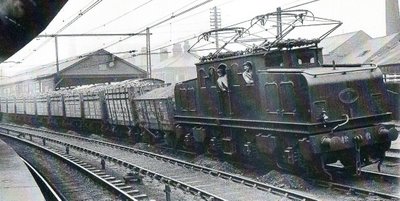
Here's an interesting archive photograph. It shows one of the Bo-Bo's designed for the Shildon - Newport electricifcation which I think was energised around 1910 and petered out just before World War Two. The electrification covered parts of the original Stockton and Darlington Railway and Clarence Railway and brought coal down from the West Durham coalfield to the docks at Middlesbrough.
Like most coal-hauling routes it lasted just about as long as the pits it served but in the quarter century that it operated it brought a huge quantity of coal to the coast.
I'd not realised until I started to travel around more just how much the twelve locos ordered by the N.E.R. for this work were modelled on eastern USA prototypes - not surprising as their C.M.E. Wilson Worsdell made a trip to look at Altoona in 1905. They would make an interesting - and rather easy - model.
The train is passing Thornaby station and I have an interesting link with it - this is where my grandfather started working as a porter for the railway in 1912. On the outbreak of the 1914 War he had vivid recollections of helping to throw drunken naval reserves who had collapsed on that platform you can see on the left onto trains bound for Portsmouth.
Friday, August 18, 2006
Coal Road

Here's a picture that brings a smile to my heart - it is on the cover of Norman Hill's book "Teeside Railways" and it shows a signal box called 'Coal Road' about two miles east of Barnard Castle. Many is the sunny afternoon that I've spent here with my grandad, it was one of his 'regular turns'and one he liked the most. There was a lovely sunny view from here over Teesdale.
It's 23 August 1952, almost exactly 54 years ago to the day eh? Two class 'J25's from Kirkby Stephen shed have just blasted up from Barnard Castle station yard heading for West Aukland with a mineral train. The fireman on the pilot engine is working hard as the safety valves are lifting, and a brisk westerly wind off the fells is carrying the smoke and steam away. I can almost hear those LNER hoppers creaking and clanking and groaning behind the engines struggling up the 1 in 60. The train engine driver is about to take the 'tablet' from the signalman for the single line ahead through Bluestone Grange cutting to Forthburn.
This might indeed be a 'family photograph' - I just can't tell. Is that my grandfather by the signal box passing the tablet to the driver. He certainly wore a waistcoat like that to work and it's his 'haircut'. And I think the motorbike parked next to the road is a Triumph 'Thunderbird'. It's probably him - I like to think so.
Thursday, August 17, 2006
At the Junction
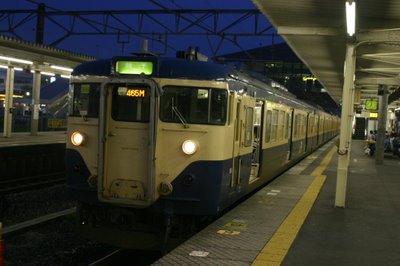
Here's the Japanese version of a scene that might please gricers the world over. It's taken at Sakura, a town about 12 miles away where our single track Sobu Line parts from the line to Narita and heads south. Actually in theory we are the 'main line' as we were built first but since the airport was constructed the Narita line has a half hourly express service and is double tracked.
Class 113 train S66 is waiting at platform two on a hot Sunday evening, air compressors ticking away and aircon units running at full notch with those doors open. It's waiting 'in the hole'. In a moment a 'Narita Express' will roar through on the adjacent platform to the left and then this train will be on it's way as service 465M, all-stations to Choshi via Narita.
This is a station full of interest and activity and it would make a great model in 'N' gauge. Maybe one day!
Wednesday, August 16, 2006
The Green Shelf

I seem to remember that there was once a movie called "The Green Mile" but here is part of the contents of "The Green Shelf" in my study.
This is my most regularly read railway book for sure. It's "Locomotives of the LNER" published by the RCTS (Railway Correspondence and Travel Society) over the years. It comes in eighteen volumes and not all are in print but if you watch UK Ebay they often come up there. Each volume is around 150 pages so that's around 3,000 pages packed with photographs of every variation in every class, details of when boilers were superheated, liveries, shed locations and descriptions of main duties. This is indeed a series for rivet counting gricers like me.
A wonderful piece of work by a whole team of writers; I think maybe the greatest railway book in the world but then I'm an LNER afficionado.
But here's a thing. Last year I tracked down one of the out-of-print volumes and thought I had the set. But then I discovered that they had published a volume 10B so I still have that to hunt down. If you ever see it let me know!
Tuesday, August 15, 2006
Long Toms

One of my favourite pastimes is rooting around in piles of old railway magazines hunting for technical drawings of locomotives. I have thousands of them. Sometimes you can get drawings in collections - like the Kalmbach "Locomotive Cyclopedia" in the USA or F.J. Roche's "Historic Locomotive Drawings". But the best fun is to root around in back numbers on some dusty shelf.
Here's one such drawing - from a 1975 edition of 'Model Railways' - a magazine of blessed memory now. It was more than a tad eccentric, there were endless detailed special articles and drawings and it the end it went bust and was resurrected to look sadly like every other model train magazine, full of adverts for Hornby trains.
It shows a Stockton and Darlington Bouch 0-6-0 as reboilered by Edward Fletcher - a class that used to be known as the first 'Long Toms' because of the length of their boilers and the way the firebox was stuck behind the rear axle. No 1275 is preserved somewhere in the UK - maybe at Shildon now or the North Road Museum at Darlington.
One day I'll get around to some serious model building with all these drawings - I promise!
Monday, August 14, 2006
2851 "Sunderland"
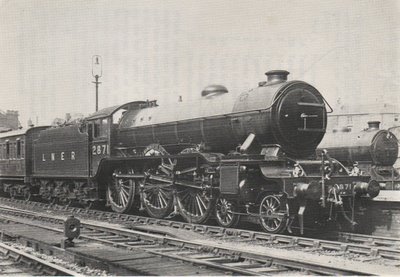
Here's an interesting story about LNER Class B17/4 that I spotted today on page 112 of "Locomotives of the LNER" Part 2b that will interest Norman as a "Sunderland Boy" himself.
The B17/4 4-6-0's were named after football teams (that's 'soccer' to you Eddie!), a series that included 2851 "Derby County" and 2854 "Sunderland".
In 1937 Sunderland got through to the Cup Final at Wembley and a special train was laid on from the north-east to London for the team and supporters. The LNER, bless them, decided that 'their team' would be pulled by 2851 "Sunderland".
But the problem was that the locomotive was in several pieces in Gorton works for a major overhaul. There was no chance of getting it back together in time so they sneakily took 2854 "Derby County" over to the works and swapped over the name plates! Right name but wrong number ...
It did the trick. Sunderland won the cup that year
I couldn't find a picture of 2851 or 2854 but here's a nice picture of 2871 "Manchester City" at Nottingham Victoria station.
Sunday, August 13, 2006
Rain, Steam and Speed ...

Mentioning the artist William Mallord Turner on my 'other blog' tonight reminded me of this famous painting of his in the National Gallery in London. Its title is "Rain, Steam and Speed ... The Great Western Railway" and it was painted in 1844.
It's an interesting picture and worth a very close look. The location is, I seem to remember, the railway bridge over the Thames at Maidenhead about 20 miles west of London and here is Brunel's railway to Bath and Bristol a few years after it opened. This is the original seven foot gauge line, and the locomotive has a very large 'haystack' copper firebox. Behind the engine is a train of open caoches with passengers huddled on their benches in heavy coats against the weather.
I guess by the early 1840's trains like this must have been working at 40 mph or even faster and it must have been gruelling to sit outside at that speed in rain or snow in the third class 'Parliamentary' carriages. I must see if I can find any contemporary descriptions. What a 'gricer' heaven though eh? I once rode behind the replica of 'Rocket' like this and it was 'ace'! Whirled along at speed in an open truck with a strange array of antediluvian motive power to see at every station! Can you imagine it?
Friday, August 11, 2006
Battle of Britain
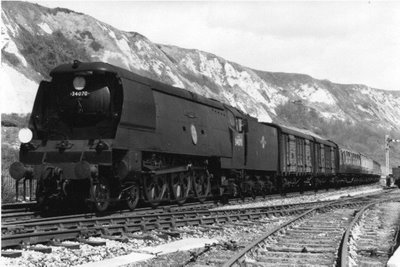
Writing about gricing at Vauxhall yesterday reminded me of the pleasures of watching Bullied's 'Pacifics' working through there - Merchant Navy Class heavy Pacifics headed for Southampton, and the lighter West Country and Battle of Britain Pacifics which could be seen on expresses down to the East Kent coast and Dover.
To us gricers at the time these engines were collectively known as "spam cans" because of the shape of their distinctive streamlining. Later most had this casing removed and they were very elegant engines.
The "Battle of Britain" class all had names related to June 1940 - squadrons, airfields and other fighter aircraft related names. Here is 'Manston' passing Folkstone. Manston was the Spitfire airfield in East Kent. Actually it's still a familiar name to UK radio listeners because it's the name of a weather station used in the daily shipping forecasts too.
Thursday, August 10, 2006
Big End Trouble
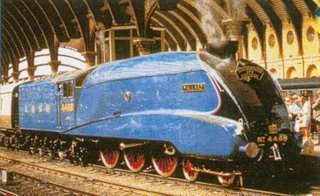 Mallard's setting up of the speed record came with a price. About a couple of years or so ago I was in the National Railway Museum in York and as luck would have it, one of the guides was an old engine driver who once drove this famous "streak." Lying besid the loco in the museum on the loco's left side is a conn-rod; the one that was on Mallard at the time of that record breaking run. The big-end bearing on the middle left hand driver had run out. Consequently the crankpin was distorted a little. The poor girl has had big-end problems ever since.
Mallard's setting up of the speed record came with a price. About a couple of years or so ago I was in the National Railway Museum in York and as luck would have it, one of the guides was an old engine driver who once drove this famous "streak." Lying besid the loco in the museum on the loco's left side is a conn-rod; the one that was on Mallard at the time of that record breaking run. The big-end bearing on the middle left hand driver had run out. Consequently the crankpin was distorted a little. The poor girl has had big-end problems ever since.It just goes to show, even machines get arthritis! But she is a beautiful old lady nonetheless. She sits in the museum beside another gracious "Dame of the Iron Road", the V2, Green Arrow. That loco has taken me from Sunderland to Newcastle on many gricing trips during my childhood. Although in those days she was a rather scruffy black arrow.
Norman
Schools
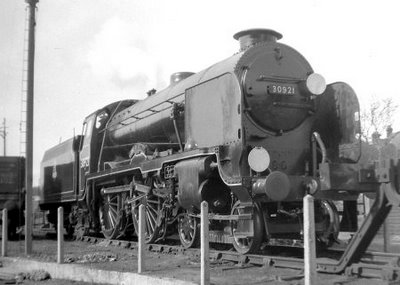
When I was in my early 'teens I'd often take a trip up to London from Sussex and 'do' the Southern Region terminals in the capital. Actually stations like Victoria, Charing Cross and Waterloo weren't very promising for gricing - there was no clear view of the platforms, but if you hung around on stations in the maze of junctions just south of the Thames - and particularly Vauxhall and Clapham Junction - there was stacks of action.
Mainstay of services then on the Kent Coast expresses were the 'Schools' class - I think Britain's most powerful 4-4-0's. Designed by Richard Maunsell they were mean looking machines with a lot of accelleration.
It never struck me at the time what a strange thing it was to do to name an entire class of railway engines after often minor English Public Schools but I guess it says a lot about the background of the Southern Railway Board of Directors. I never did see "Ifield" or "Marton Road" speeding by!
One of the class - "Repton" - found it's way to the railway museum in Vermont
Wednesday, August 09, 2006
Matchless Lawns
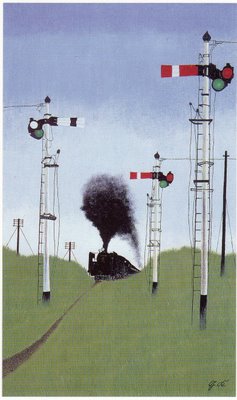
I was in Naruto at lunchtime and as we drove over the Togane Line level crossing I couldn't help noticing how matchless lawns - or maybe even meadows! - rolled away on both sides of the road. It's quite a busy line - trains about every half hour - but by August JR East seem to give up entirely on weed control on its more rural lines. The rails had vanished into vegetation.
It reminded me of this postcard I bought a while back down in Boso Hanto - a recollection by a local artist of the trains of his youth in leafy Chiba-ken. Here a smokey 4620 Class 2-6-0 is picking it's way through the meadows on a summer's day back in the 1950's and the track simply isn't to be seen.
I wonder how they handle weed control these days. Over Stainmore in the 1950's they had a herbicide spray train in May and that was enough to see off our feeble northern English weeds. I can't image that it's all so innocent now.
Tuesday, August 08, 2006
Changing Engines

Norman has sometimes posted pictures taken at Carlisle Citadel station but here's one taken fifty years ago. It must be just after eleven - the 'up' 'Royal Scot' has just rolled in from Glasgow and the Polmadie shed 'Duchess' is being changed for one of the Carlisle 'Duchesses' to take the train on to London. In a couple of hours the Scottish engine, coaled and watered, will take the 'down' northbound 'Royal Scot' back across the border
Changing engines at intermediate stations on long distance trains became quite common in Briitain in the 1950's to balance crew workings. On the East Coast Main Line the change was usually made at Grantham.
Here on the west coast though it was essential - the tenders just didn't have the capacity to carry enough coal for the two big climbs at Shap and Beattock
Monday, August 07, 2006
3 July 1938
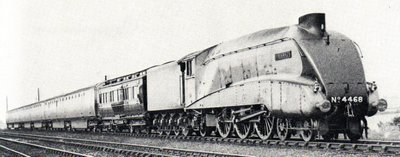
Here's a couple of interesting old photographs I've shamelessly borrowed from my copy of O.S.Nock's "The Gresley Pacifics" omnibus edition. It's long out of print but you can get a secondhad copy - take a look here.
The photo at the top is Mallard lurking in the 'up' loop at Barkston just north of Grantham on Sunday 3 July 1938 with Nigel Gresley himself aboard. This was supposed to be a routine brake test of new rolling stock comparing air and vacuum brakes but the coach slipped in behind the locomotive suggests all is not what it seems. It's the old N.E.R dynanometer test coach, now in the National Railway Museum at York.
A few minutes later the train pulled out onto the main line towards Peterborough and London. It stormed up to Peascliffe tunnel on full throttle and as it began the descent of Stoke Bank that regulator stayed full open and everyone hung on for dear life. Some miles down the bank at Tallington the train reached the world speed record for steam which still stands today - 126.7 m.p.h
Below is a picture of the crew in charge of this risky enterprise - a bunch of pretty fearless Yorkshiremen eh? From left to right Fireman Bray, Driver Duddington and Inspector Jenkins. I've got a cap like that too.

sss
Sunday, August 06, 2006
Those 'German' blinkers
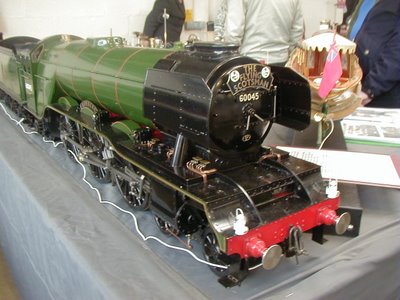
I'm sure that I've said a million times before that my favourite class of LNER engines was the A3 Pacfics, and I think from various things he said that they were Nigel Gresley's favourites too. The had a kind of 'racehorse' elegance to them that you really only saw in motion. And how fast they could move eh! I was suddenly reminded of it again last night watching a new DVD of film from the 1950's and 1960's. Streak lightning!
One problem that dogged the A3's for much of their operating life was the risk of exhaust smoke drifting down at speed and spoiling the driver's view. Eventually in the late 1950's nearly all of them were fitted with double blastpipes and a Kylchap exhaust arrangement and also a rather 'German' looking pair of 'blinkers' - the smoke deflectors at the sides of the chimney.
Not only did this cure the smoke problem but in the opinion of many it made a beautiful locmotive even more beautiful despite completely changing the appearance
Here's a 1:12 model I saw at Harrogate Show two years ago of 60045 'Lemberg' sporting German 'blinkers' and also a 'Flying Scotsman' headboard. She looks as good as the real thing!
Saturday, August 05, 2006
Newcastle and Carlisle
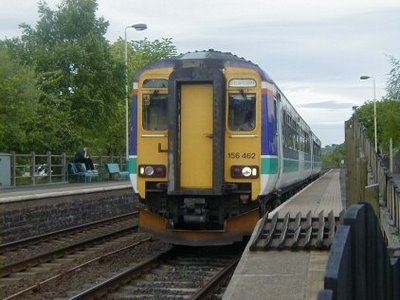
It's a surprising thought that in some parts of Britain we are edging up towards the bi-centenary of some of our railways. The line between Newcastle and Carlisle is one of them.
The route was actually staked out within a few years on the completion of the Stockton and Darlington Railway and completed in 1838. At that time it was quite separate from the other railway developments in England and has it's own distinctive styles of civil engineering and buildings. It became part of a wider North Eastern Railway system in the 1860's.
The line runs up the rural valley of the Tyne through Hexham, Haydon Bridge and Haltwhistle and then across the gap and down towards the Solway Firth and Carlisle. Not only is it a very pretty route but it's aways been able to handle the largest of locomotives so, although it's not a first league 'main line'it's had some interesting workings over the years. A good modelling project!
Here's a Scotrail 156 unit passing (as most trains do!) Haydon Bridge station headed for Carlisle then over the border and up to Stranraer for the boat to Larne and connecting train to Belfast. Once there was a direct line from Carlisle to the ferry but these days trains have to head almost as far north as Glasgow, cut over to Ayr and then down the Firth of Clyde coast.
Friday, August 04, 2006
91 At Newcastle
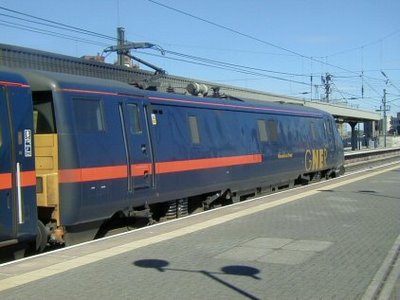
Here's a rare picture - Newcastle on a sunny day! No, only joking of course ...Newcastle is famous for sunshine as everyone knows.
When the East Coast Mail Line was electrified in the 1980's the Class 91's were introduced as the 'top link' electric motive power. The voltage is the same as the West Coast Line - 25kv.AC - but actually I'v never seen a locomotive from either route on the other so that's one bit of standardisation that turned out to be irrelevant - so far.
Perhaps with rising oil prices they could link the two across country with a new electrification through Sheffield. Hey! Even better! They could try designing locomotives that run on coal eh? How would they work? You could have some cylinders at the front and ...
This is 91 107 'Newark of Trent' in 'GNER' livery and about to start for London. It's at the back of the train - these are very high speed 'push-pulls' with a driving trailer at the south end and locomotive at the north end. Why anyone would want to call a locomotive 'Newark' - a small and undistinguished town on the ECML - beats me. But there are odder engine names these days.
The 91's have 'cruise control' and a top speed of 140 mph but they are limited in service to 125 mph. They are 'odd ended' and were built so that at night they could be used on freight trains and driven from either end but on passenger trains they are always wired up like this. Actually I've never seen one either used on a freight train or being driven 'B' end first either. Some more redundant flexibility I guess.
Tuesday, August 01, 2006
Step along there ...
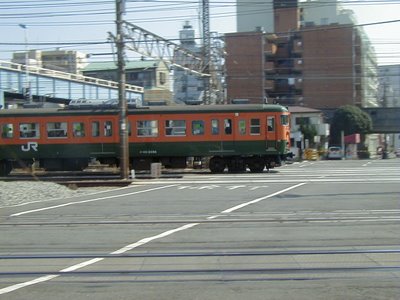
Now this really IS a level ('grade') crossing. It's at Tsurumi about 15 miles south of Tokyo and this is what used to be the lane up to Sojiji Temple.
Reading from this side .. two tracks to Yokosuka, two tracks Keihin local, four tracks Tokaido line and two tracks freight to Yokohama. So step along please - you have ten tracks to get across before those barriers come down! Actually all these lines are so busy I guess that the barriers stay down around 80% of the time.
Whizzing by in this picture is a kaisoku semi-fast on the Tokaido Line - it's a 113 Class but a different colour scheme to the Chiba lines - what I like to think of as the 'Irish Flag' orange and green version.
Oh! And that isn't all the gricing to be had here. Just beyond the crossing that low bridge is a private railway down to Yokohama and I'm actually standing under the Tsurumi Line to take this picture - so there are fourteen tracks in total here ...
